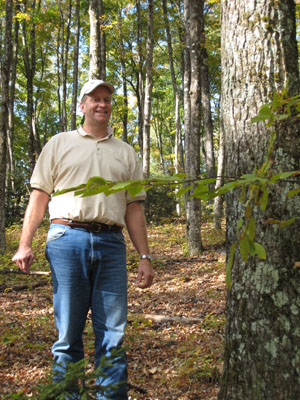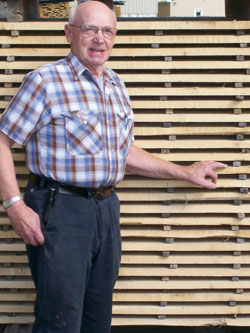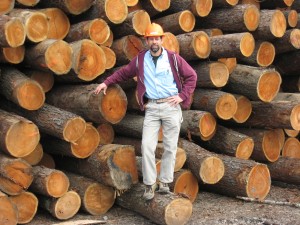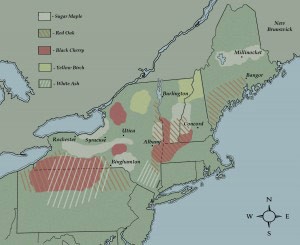In the kitchen cabinet trade, hard maple is king these days. Also widely used for flooring and trim, hard maple is highly valued for its durability and light-colored sapwood. As Dave Clements and I stand talking in Allard Lumber’s modest log yard in Haverhill, New Hampshire, most of the wood piled around us is hard (also called rock or sugar) maple.
Clements buys logs and timberland for Allard. This log yard, perched on the east bank of the Connecticut River a hundred miles north of Allard’s mill in Brattleboro, was strategically placed here in 2001 for purchasing and stockpiling high-quality hardwoods from central sections of both Vermont and New Hampshire. Clements glances at the hills across the valley and says simply, “This land wants to grow maple.”
Most of the Northeast is covered by forests. While trees can grow anywhere, not all sites produce beautiful furniture-grade wood. There are hot spots sprinkled throughout the region where the conditions are right for certain hardwood species to thrive. People who buy logs and lumber for a living know these areas and try to concentrate their efforts there.
While Clements thinks most of Vermont has the capacity to grow good maple, at this yard he’s getting his best logs – straight, nearly or entirely knot-free on the surface, and with a small heart – from Windsor and Orange counties. He also gets high-quality hard maple from down into Windham County and over into New Hampshire’s Grafton and Sullivan counties.
Clements’s overall assessment of Vermont as a source of good maple is echoed by both George Story and Chris Castano, though they both look more to New York state. Story owns General Timber, a company based in Fort Edward, New York, that exports high-grade logs to Asia and Europe. He finds his best hard maple – with tight, even growth rings and very light coloring – north and west of Syracuse along the southern shore of Lake Ontario, and also along the east side of the Hudson River in Washington County. These areas, he notes, are good farmland with rich soils. Farther south, he finds the wood tends toward a yellow color, an appearance he attributes to higher sugar content.
Chris Castano buys and resells hardwood lumber for Champlain Hardwoods out of Essex Junction, Vermont. Hard maple comprises nearly half of the company’s business, and Castano finds that the best small-hearted trees grow around Binghamton, New York, and to the east of there. “The sandy, loamy soils are optimum in that area,” he notes. “There’s consistent precipitation and a longer growing season with more moderate temperatures than you get to the north.”
For his whitest, clearest maple, Tom Gerow splits the difference between Story’s favorite stretch along Lake Ontario and Castano’s closer to the Pennsylvania border. Gerow – in charge of log buying for Wagner Lumber, a major manufacturer of furniture-grade lumber with three facilities in New York’s Southern Tier, together churning out 55 to 60 million board feet per year – looks to what he calls the lime belt. This band of glaciated, calcium-rich soils spans the center of the state from south of Utica, west through the Finger Lakes region, and out past Rochester.

Photo by Virginia Barlow
Sound confusing? René Germain had hoped to sort it out. Germain is an associate professor in the Department of Forest and Natural Resources Management at State University of New York’s College of Environmental Science and Forestry (SUNY-ESF), and he was part of a research project aimed at figuring out regional differences in hard maple quality, especially heart size. The investigators were very disappointed: while the data are still being analyzed, so far they haven’t shown much. “From a macro-perspective,” he says, “no area – from Michigan to Vermont to New York to West Virginia – can claim to have whiter maple with a smaller heart.” The effort is now in a second phase, looking for micro-site conditions within New York state: soil types, land-use history, past ice storms, and so forth. Germain thinks there might be trends emerging, but nothing is yet confirmed. “We have no earth-shattering news,” he says wryly. “No smoking gun.”
From long experience handling logs and lumber, Reuben Lumbra – whose family-owned mill has operated in Milo, Maine, since 1960, when he and his father moved the business from northern Vermont – confirms the basics: hard maple likes rich soil and a slope that’s gently warmed by the sun, but is not subject to over-drying as a southwestern aspect would be. His family’s mill is 40 miles north of Bangor, and their best maple grows nearby, from Moosehead Lake east through Millinocket and over toward the New Brunswick border. Once you get up around Mount Katahdin – just as with other high, rocky portions of New England and New York – Lumbra says the maple starts showing many more defects, such as mineral deposits in the wood and areas of ingrown bark.
On the other hand, he notes that not all defects are always defects. Lumbra says that birdseye, for example, is a sign of stress and tends to occur on higher, rougher ground. “The old forest had a high percentage of birdseye, which, at that time, wasn’t favored as it is now. Today it’s very, very much in demand,” Lumbra says.
Red Oak
Changing tastes in the end-user market link the shifting fortunes of hard maple with those of a very different tree. Red oak grows from Maine to Georgia and west to Iowa. The bulk of the tree is heartwood with only a narrow ring of sapwood around the periphery; it’s the heart that’s highly valued for its color. And what color is that? Well, it depends.
For exports, Story looks for a pinkish red tint and finds his best logs in the western Berkshires of Massachusetts, in southwestern New Hampshire and southern Vermont, around New York’s Lake George and on up through the northern Hudson Valley along Lake Champlain. Allard Lumber, says Clements, looks for a similar even, red color within trucking distance of Brattleboro: southern New Hampshire and Vermont, northwestern Massachusetts, and southeastern New York. “Good red oak also fingers up the Connecticut River Valley, especially on the New Hampshire side,” he observes. He attributes those “fingers” along Grafton and Sullivan counties to micro-climate. Looking up into the thick fog that still blankets the river at 10:00 A.M., he says, “It’s always like this here.” Having just driven down from the upper Winooski Valley, I know that the sky above the fog is a perfectly clear, bright – and frosty – blue.
Given oak’s preference for warmer climes, Lumbra doesn’t see much at his family’s mill. He says the best in Maine – with healthy growth and a rich, red color – comes from along the state’s southern coast, south of Route 2.

at his family's Milo, Maine mill
Photo by Laura McMahon
But “red” isn’t the only hue sought after in red oak. For some sectors of the domestic market these days, it isn’t even the primary color. Castano observes that in the 1970s and 80s pinkish red oak was the standard for cabinet companies and was used in every fast-food joint and supermarket across the country: “People got sick of it, so they’ve been looking for something different.” In many cases, that something was hard maple. As Dave Clements puts it, “All of a sudden, everyone wanted white furniture, white cabinets, white floors, and the price of maple shot up.” In red oak, people have discovered creamy, tan “wheat,” a color that has been gaining popularity as oak is used more and more for flooring and trim, relinquishing the cabinetry market to hard maple and cherry.
Though the precise factors that cause red oak’s wide color variation are unknown, “wheat” becomes more prevalent as you head south. But there are a couple of catches. For one thing, the farther south you go, the longer the growing season. As red oak’s annual growth rings get larger, the appearance of the wood changes. An already porous, open-grained material begins to look rough. “It doesn’t even look like the same wood,” comments Castano. Where do these two sought-after qualities – tight northern growth rings and the newly popular southern wheat color – meet? “North of Interstate 80 in Pennsylvania is where you get into high-quality red oak,” says Gerow, “and it continues up into the middle of New York State.”
The other catch is that, south of New England, not all red oak is red oak. Roughly 30 other species of “red oak” sometimes get mixed in with true northern red oak (Quercus rubra). Mineral streaks and other defects are more common in these other species, giving southern red oak a bad name in the lumber market.
Everyone agrees that red oak doesn’t do as well in the northern reaches of New England and New York. There, oak is pushing the edge of its cold tolerance and has more trouble with insect damage. It shows more defects such as mineral deposits. Although you can find red oak on rocky ridges, it sends down a taproot and prefers well-drained soil, so it grows better on gentle terrain than it does in the mountains. That counts out much of Vermont, which Castano half-jokingly describes as “one big rock with some clay thrown in.”
Black Cherry
Black cherry does little better than oak in northern portions of the region. And when it comes to cherry, there is simply no debate. The best – not just in the Northeast, but in the world – grows in northwest Pennsylvania’s Potter and McKean counties, and in the flanking counties of Tioga and Warren and the adjoining stretch of southwestern New York. There, cherry grows quickly and with a narrow sap-ring; like red oak, cherry is sought for its heartwood. The cherry of this region grows in an even, rosy hue with very low sap content and little defect of any kind: few knots and hardly any mineral or “gum” deposits. In short, it makes perfect cabinetry and furniture.

Why does cherry grow so well in this part of the Northeast? Gerow notes that the climate is optimum and that geologic history is a factor, providing the region with ideal unglaciated soils. Unlike some species – maple, for instance – that grow better in soils with calcium and magnesium, cherry seems to prefer soils rich in nitrogen, which are abundant in this part of Pennsylvania. As Castano points out, it’s also a matter of human intention. Castano, who worked for the Pennsylvania Bureau of Forestry in the 1980s, calls it “one of the most sophisticated forestry services in the country,” and says there simply aren’t many places in the Northeast where so much effort has been expended to promote a tree species. “The State of Pennsylvania owns a lot of acreage in the western part of the state,” he says. “They know they have a valuable crop, and they spend a lot of money on regeneration.” He reports that, in his time there, the Bureau of Forestry ran electric fencing around large tracts to keep deer from browsing cherry seedlings. The Bureau also had a serious herbicide spray program to eliminate the ferns that can quickly shade out small tree seedlings. “And,” adds Castano, “some of the large trees – with stems straight and clear for 20 or 30 feet – are left as seed trees. They don’t take out all the good ones.”
Gerow agrees with Castano’s thoughts on management. There is, in cherry as in every species, variation within any given area. While climatic and soil conditions determine a site’s potential, that potential can easily be overridden by human impact. “Was the area high-graded? Or pastured and subjected to soil compaction, root disturbance, and bark damage?” Gerow asks. “Or was it well managed?”
Looking farther south into Pennsylvania, George Story finds that the sap and gum content of cherry increases. And as you head farther north and east into New York and across into New England, you find smaller trees with more gum, more knots, and a spottier, harsher red color. That said, there is still good cherry to be had elsewhere in these northern woods. Gerow notes that there are “somewhat inexplicable pockets” of high-quality cherry in New York’s Chenango County, in the Catskills, and on the Tug Hill Plateau.
In northern New England – well outside cherry’s ideal zone – Clements sees little of it, the best coming from the same areas where Allard Lumber looks for oak. In Maine, Reuben Lumbra reports that the family mill hardly processes any at all. There, he says, cherry tends to be more diseased than elsewhere in the region.
Yellow Birch
The conditions that cherry and oak dislike, yellow birch loves. In northern Maine, Lumbra finds it growing well in the same areas as maple. In Vermont’s northeastern Essex and Caledonia Counties and across into northern New Hampshire, Clements observes that it likes cold, northwestern slopes and can tolerate extreme conditions even more easily than maple. A year ago, Allard Lumber bought 100,000 board feet of good yellow birch from state land in Victory, Vermont, in the Northeast Kingdom. When George Story wants yellow birch, he looks to these same northern woods and to the Adirondacks.
Yellow birch represents only a small fraction of the hardwood market, but that may be changing. “To me, it’s probably the prettiest wood there is,” says Castano, who sees it starting to gain popularity in flooring, cabinetry, and furniture. It is, he points out, one of the only species where both the heart- and sapwoods are desirable. Many sawmills separate the two kinds of boards – which are about equal volumes in the average log – and get premium values in return. The heartwood, often called “red birch”, commands top-end prices. “It has similarities to cherry,” says Castano, “without the inherent defects of cherry, like gum and small pin knots.”
White Ash
For somewhat mysterious reasons, white ash also has only a small market share. “Ash is kind of a bad word in this industry,” says Dave Clements with a laugh. When hard maple values soared in recent years, soft (or red) maple followed suit as a less-expensive alternative. Clements is surprised that white ash – also with light-colored sapwood, but with an open grain similar to oak – didn’t make gains as well. While it is used for furniture and occasionally in flooring, it just hasn’t caught on. “With today’s fuel costs,” observes Clements, “loggers almost can’t afford to harvest and truck lower-grade ash.”
Ash has Castano baffled, too: it often grows tall and straight; it saws well, showing few defects; it dries well and is durable and resilient. And it’s cheap. “We can’t figure out why it’s not more popular,” he admits, “It’s frustrating for us.” Castano gets his best ash – small-hearted and light-colored – from southeastern New York, while Tom Gerow looks a little farther west in central New York and south into central Pennsylvania. The species is scattered throughout New York and New England, though northern areas don’t tend to produce such large trees. In Maine, Reuben Lumbra sees white ash mixed into a variety of forest types. “We have a lot of white ash here in the Northeast,” concludes Castano, “and we’d love to see it sell better.”
Responding to Change
It remains to be seen whether ash, or yellow birch for that matter, will have a chance to achieve full economic potential. At SUNY-ESF, René Germain warns that both species are getting hit by a variety of pathogens and are in decline. Especially in ash, he’s seeing a lot of crown dieback. And emerald ash borer – an Asian beetle that made its devastating North American debut in 2002 – is radiating in all directions from Michigan, and has already reached western Pennsylvania.
But change – in consumer tastes, in global economics, in land-use and management patterns, in ecological factors – is what the wood business is all about. Over the course of five decades in Milo, Maine, Reuben Lumbra has seen a lot of change. “I’ve seen the old forests and I’ve seen regeneration a couple of times,” he says. Around 1970, he recalls the family mill bought excellent hard maple from a site 20 miles away. In the nineteenth century, there had been an iron smelter in the area and the woods were heavily cut for fuel. After the smelter closed around 1900, the forest came back, offering a good timber harvest seven decades later.
Thirty and forty years ago, most of the mill’s hardwoods went to furniture, a bit going to other products like bobbins. “Today,” says Lumbra, “furniture is probably our smallest market. A lot of furniture plants have gone to China.” Now most of their domestic sales go into kitchen cabinets, flooring, and architectural details for high-end homes. And some of their lumber – particularly white ash – goes overseas, as exports have become a big factor in the past 15 years.
“This whole industry is very fluid,” says Dave Clements. “We’re always adjusting.”



Discussion *